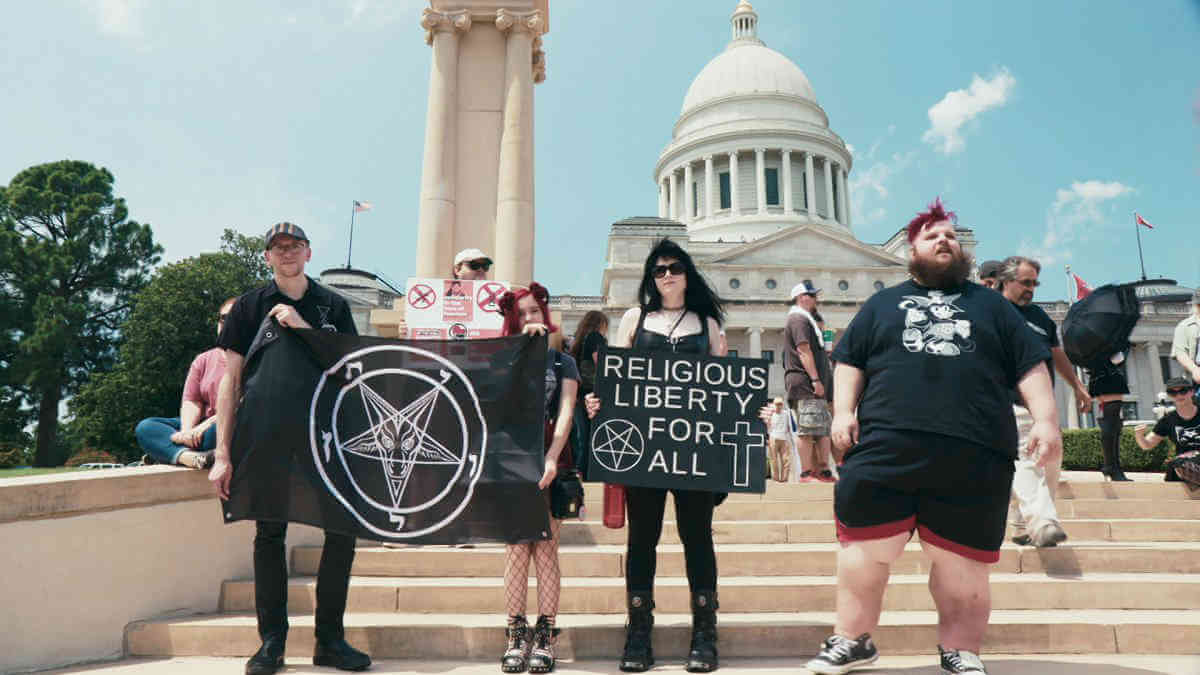In its six years of existence, the Satanic Temple has managed something remarkable: rebranding Satanism as enlightened and politically progressive. Penny Lane’s documentary “Hail Satan?” makes no attempt to hide the fact that it’s on their side, and the Christians here come across as hateful and dangerous, not the Satanists.
To get one thing out of the way, the Satanic Temple does not literally worship Satan or believe in him (or God). In fact, the film’s early scenes show one of its members going shopping for a costume to portray a properly theatrical Satanic image to troll US Senator Rick Scott, who was then Florida’s governor. But the temple’s followers now define themselves a non-theistic religion, with seven ethical tenets that make good sense. The film testifies to the sense of community their members, including many LGBTQ people who have good reason to feel alienated by Christian conservatives, have found.
“Hail Satan?” benefits greatly from its sense of humor. For that matter, so does the Satanic Temple. The campy theatricality running through their use of occult imagery is very different from the black metal scene. One of their early actions was a “Pink Mass” at the grave of Fred Phelps’ mother, which riffed on Mormons’ posthumous and unauthorized conversions to their church by “converting” her to lesbianism. Two same-sex couples kissed, and spokesperson Lucien Greaves rubbed his testicles on her headstone. The Yes Men, who have impersonated CEOs and government officials to promote leftist politics, are a probable inspiration. When Lane films Satanic Temple members who want to remain anonymous, she puts them in black jackets and devil horns even as she hides their faces.
“Hail Satan?” goes through a fairly linear history of the Satanic Temple, which it portrays as a gag tried out at a few protests that became increasingly serious and popular. The film also provides a more general background on religion in the US via scholars Kevin Kruse and Jay Wexler. While I remember the “Satanic panic” well from being a teenager in the ‘80s, it was news to me that the “one nation under God” language in the Pledge of Allegiance and “In God We Trust” language on currency date back only to the 1950s. The film also reveals that many Ten Commandments monuments on public property were originally planted there to get publicity for Cecil B. De Mille’s film.
In its last half hour, “Hail Satan?” builds dramatic momentum around the expulsion of Jex Blackmore, who headed the Satanic Temple’s Detroit chapter, for a performance — that’s honestly the best way to describe it — in which she stuck pig heads on spikes and said “Execute the president!” To Greaves, this called for the murder of Donald Trump and broke with the Satanic Temple’s firm policy of nonviolence. To me, Blackmore’s action was clearly a bit of heated rhetoric, and while I understand the need for the group to cover itself legally, perhaps demanding that Blackmore make clear she wasn’t actually advocating murder would’ve been a better idea than kicking her out.
The people critical of the Satanic Temple in “Hail Satan?” are mostly seen in news footage, and they’re almost entirely conservative Christians who view Satanism in a completely literal way. You wouldn’t know from this film that they’ve been criticized from the left, as well. Greaves’ choice of lawyer Marc Randazza, who has also worked for Alex Jones and several alt-right figures, to represent them in a 2018 lawsuit against Twitter led their Los Angeles chapter to split off. “Hail Satan?” celebrates the group’s expansion and current status as a more conventional religious and political organization. That did not come without compromises.
However, the bigger picture “Hail Satan?” sketches says something telling about American culture. To many of the teenagers who would ultimately join the Satanic Temple and to the far bigger group who sat on the sidelines, the Satanic panic made Satanism look cool and those Christians who thought Dungeons and Dragons and backwards messages in Led Zeppelin records would destroy a generation look foolish. The hypocrisy of the Catholic Church freaking out over a Black Mass the Satanic Temple wanted to hold at Harvard while remaining silent about its complicity in institutionalized pedophilia is glaring.
In America, the name Satan and images of pentagrams and upside-down crosses have a mythic power that goes beyond simple atheism. The Christians who show up at school board meetings fearing for their souls at the concept of an “Afterschool Satan Club” or a Satanist prayer invocation don’t appreciate the importance of critical thinking and the notion that religious freedom involves coexistence with genuine differences.
On the Satanic Temple’s part, there’s something very valuable about their insistence on the role of humor in activism, building community around a concrete set of ethics, and trying to re-define religion in a way that’s open to ambiguous belief or none at all.
However, the group may be turning into another branch of organized religion built around a charismatic male authority figure, despite its professed atheism. “Hail Satan?” is very entertaining, but it clearly seems made for an audience that’s never thought about these subjects and expects Satanists to sacrifice cats while listening to Slayer amid spray-painted pentagrams.
HAIL SATAN? | Directed by Penny Lane | Magnolia Pictures | Opens Apr. 19 | IFC Center, 323 Sixth Ave. at W. Thirds St. | ifccenter.com
































